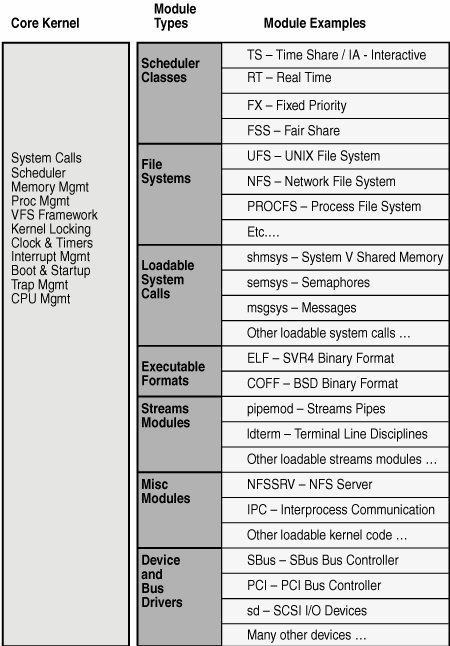Section 1.3. Kernel Overview
1.3. Kernel OverviewThe purpose of any operating system is to provide an execution environment for applications, managing and allocating the underlying hardware resources such that applications get execution time on processors, have their active address space segments resident in physical memory, are able to do I/O to files and devices, and can communicate over a network. The operating system must be able to execute multiple applications, support multiple users, effectively manage a wide range of hardware platforms, and provide facilities for managing (controlling) and observing (troubleshooting, diagnosing) the workloads running on the system. We refer to the core operating system components and subsystems as the kernel. The primary functions of the kernel can be divided into two major categories: managing the hardware by allocating its resources among the programs running on it; and supplying a set of system services for those programs to use. The Solaris kernel, like other operating systems, provides a virtual machine environment that shields programs from the underlying hardware and allows multiple programs to execute concurrently on the hardware platform. Each program has its own virtual machine environment, with an execution context and state. The basic unit of a program's environment is known as a process; it contains a virtual memory environment that is insulated from other processes on the system. Each Solaris process can have one or more threads of execution that share the virtual memory environment of the process, and each thread in effect executes independently within the process's environment. Think of the process as an execution container for one or more threads. The Solaris kernel scheduler manages the execution of these threads (as opposed to management by scheduling processes) by transparently time-slicing them onto one or more processors. The threads of execution start and stop executing as they are moved on and off the processors, but the user program is unaware of this. Each time a thread is moved off a processor, its complete execution environment (program counter, stack pointers, registers, etc.) is saved, so when it is later rescheduled onto a processor, its environment can be restored and execution can resume. Mechanisms in the kernel can access operating system services, such as file I/O, networking, process and thread creation and termination, process control and signaling, process memory management, resource control and management, and interprocess communication. A process accesses these kernel services through the use of system calls. System calls are programming interfaces through which the operating system is entered so that the kernel can perform work on behalf of the calling thread. 1.3.1. Solaris Kernel ArchitectureThe Solaris kernel is grouped into several key components and is implemented in a modular fashion:
1.3.2. Modular ImplementationThe Solaris kernel is implemented as a core set of operating system functions, with additional kernel subsystems and services linked in as dynamically loadable modules. This implementation is facilitated by a module loading and kernel runtime linker infrastructure, which allows kernel modules to be added to the operating system either during boot or on demand while the system is running. The Solaris module framework supports seven types of loadable kernel modules: scheduling classes, file systems, loadable system calls, loaders for executable file formats, streams modules, bus or device drivers, and miscellaneous modules. Figure 1.1 shows the facilities contained in the core kernel and the various types of kernel modules that implement the remainder of the Solaris kernel. Figure 1.1. Core Kernel and Loadable Modules |
EAN: 2147483647
Pages: 244
